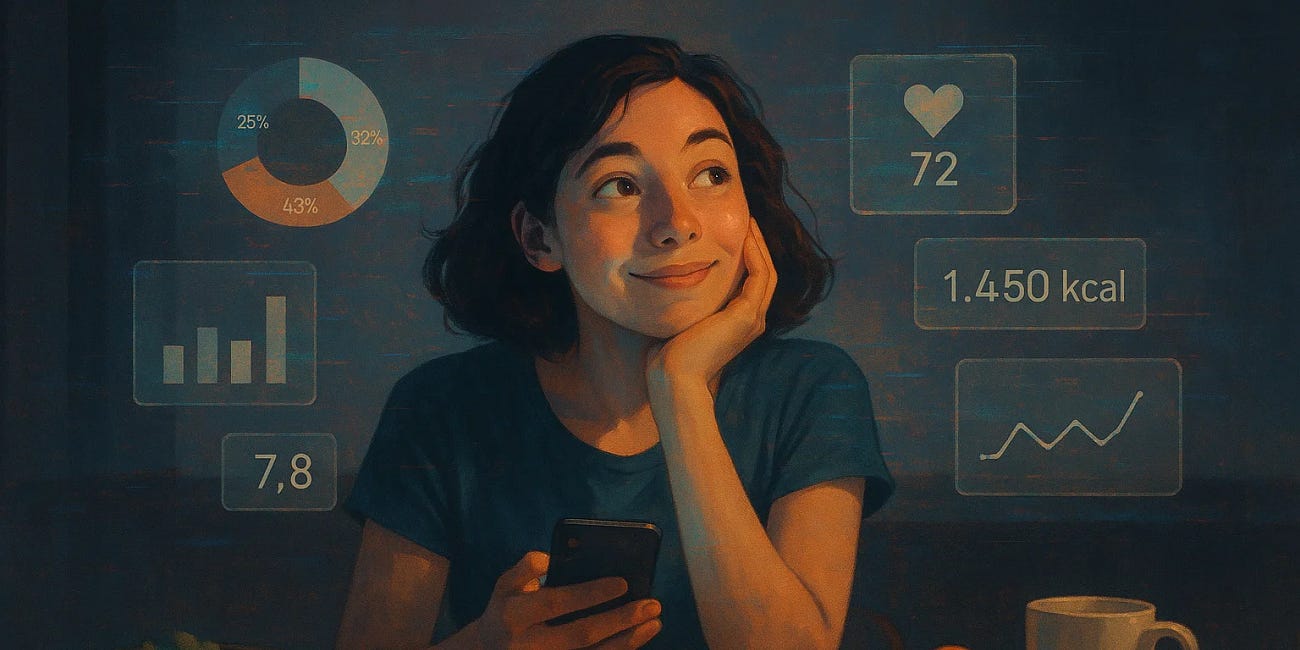Why most AI marketing strategies fail (and what top CMOs do differently)
While you’re tweaking CTAs, the world is using AI to feel more understood and connected
I used to think AI in marketing was mostly about speed: sharper copy, cleaner funnels, workflows that ran without friction. A toolset built for doing more, faster.
But then I noticed something I couldn’t unsee.
While we were asking ChatGPT to polish headlines or rewrite our CTAs in three variations, millions of people were opening the same interface to unpack grief, to redefine their purpose, to process stories too raw to say out loud.
And that’s when it landed.
GenAI isn’t just a productivity engine.
It’s a mirror.
People aren’t using it just to optimize.
They’re using it to feel. To think. To find something true inside the noise.
We talk about value, but what we’re chasing is resonance.
Not better marketing. Deeper connection.
And meanwhile, we’re pointing this power at the footer of an email.
We’re applying precision to surface-level tweaks and calling it transformation.
But the real waste isn’t that we use AI for the small things.
It’s that we stop there.
Because what this moment offers - to marketers, strategists, founders, writers - isn’t just a shortcut.
It’s a shift.
A redefinition of how we relate, how we speak, how we build trust in a world where human tone has become the rarest signal in the feed.
This isn’t just about CMOs.
It’s about anyone bold enough to say: I still believe clarity matters more than cleverness. That connection, not optimization, is what converts. That using AI well doesn’t mean sounding perfect. It means sounding real.
🧰 The Better Your Strategy, The Smarter AI Becomes
For a while, I thought that using ChatGPT was mostly about getting things done faster: clearer headlines, more efficient workflows, smoother copy. And honestly, it did help.
But over time, I started noticing something. Even though the writing looked polished on the surface, something about it felt thin underneath.
Because AI doesn’t create clarity, it reflects it.
It doesn’t think for you, it just amplifies the thinking you bring to it.
It’s not just a mirror. It’s a magnifier, and what it reflects is shaped by the clarity you bring into it.
If the brief is generic, the output will be too.
If the strategy is vague, the result will sound like it’s trying to be helpful but doesn’t really know what it’s solving.
And that’s why I stopped obsessing over “smart” prompts and started spending more time sharpening what I actually wanted to say.
Because once you realize that the model is only as good as the questions you ask it, and the clarity behind those questions, everything shifts.
And sometimes, it doesn’t even take to read the answer.
Sometimes, just writing the prompt helps me see the gap.
And once you start noticing that shift in your own writing, you can’t help but see it everywhere, especially in the content brands are putting out today.
🧠 You Don’t Need Better Prompts. You Need Emotional Relevance
We’re surrounded by AI-generated content. Headlines optimized for clicks, product pages rewritten for SEO, and social captions that sound just human enough to pass. But the more of it I see, the more I realize that what actually stands out isn’t polish or precision. It’s presence.
Because empathy isn’t some optional finishing touch you layer on after the funnel. It’s what shapes the message before a single word gets written.
It’s not about sounding friendly or “human.”
It’s about showing that you actually understand who you’re talking to, what they’re dealing with, and why any of this should matter to them in the first place.
The brands that resonate today aren’t adding empathy as an ingredient at the end.
They’re building around it, using emotional relevance as a foundation.
And when your strategy starts from conversion goals instead of actual insight, you might get content that looks right on the surface: well-formatted, well-written, structurally sound, but somehow still misses the mark.
Because that’s the part AI still can’t touch.
It can reflect patterns, sure.
But it can’t guess what your audience is struggling to articulate.
That’s still on you.
And the brands that learn how to do that, to feel instead of just format, won’t sound like marketers.
They’ll sound like someone who actually gets it.
And that’s what people remember.
🧠 What if that story that made you cry was written with ChatGPT?
You’re halfway through a novel that’s hitting you right in the gut. It’s beautiful. Honest. Maybe even painful. You close the book for a second, dry your eyes, and then you read: “written with AI.”
🏗️ The Adoption Gap Isn’t Technical. It’s Cultural.
What’s holding most companies back from adopting AI at scale isn’t a lack of tools, budget, or technical talent. It’s mindset.
It’s the hesitation that shows up in meetings as “let’s wait and see,” the nervous glances when someone says “automation,” the quiet worry that these systems are here to replace rather than support.
But AI doesn’t replace people.
It replaces friction.
It frees up time, clears out the repetitive tasks, and creates space for better thinking, not less involvement.
And no, you don’t need a dev team or a six-month roadmap to start.
The ecosystem is already full of no-code tools - from OpenWidget to Flowise, ManyChat to Zapier - that let marketers, teams, even solo contributors build smart, responsive workflows without writing a single line of code.
Which is why the real question isn’t can we do this?
It’s what’s stopping us from trying?
Because “waiting to see” might feel like prudence.
But in this cycle, it’s often just a slower way of falling behind.
🧠 The Real Competitive Edge? People Who Adapt Fast
As AI continues to shift the pace and nature of how we work, the real differentiator isn’t speed, or even skill, it’s adaptability.
Because in a landscape where so much can be automated, optimized, or outsourced, what remains irreplaceable is the way people respond when the playbook no longer applies.
It’s not about who already knows the answer, or who’s memorized the latest frameworks.
It’s about who’s willing to ask better questions.
Who’s curious enough to try something untested.
Who’s flexible enough to unlearn.
And who’s sharp enough to listen, absorb, and recalibrate, even in motion.
The people who thrive in this environment aren’t necessarily the most experienced or senior.
They’re the ones who are still learning, and willing to learn differently.
Because the ones most at risk aren’t the juniors, or the ones still finding their footing.
They’re the ones holding tight to systems that no longer fit, hoping the rules will stay still long enough to catch up.
And the real danger?
It’s not just about falling behind.
It’s about giving away too much trust, too quickly, to tools evolving faster than we’re equipped to question them.
The danger is to handover too much power to systems evolving faster than our ability to understand them.
That’s why the edge, now more than ever, is human.
Attentive. Responsive. Emotionally intelligent.
🧠 Final thought
The real divide isn’t between those who use AI and those who don’t.
It’s between those who still treat it like a shortcut, a faster way to repackage the same thinking, and those who are beginning to see it for what it really is: a mirror, a magnifier, a tool that expands whatever intent you bring into the process.
Because you don’t win in 2025 by sounding more optimized.
You win by sounding more you.
By writing with the kind of clarity, depth, and emotional relevance that cuts through the noise not because it’s polished, but because it resonates.
And yes, when we talk about this, we’re talking to ourselves too.
Because it’s easy to drift.
To write for algorithms instead of people.
To optimize for output instead of reflection.
So we try to check ourselves, every time:
Are we using these tools to connect or just to produce?
Are we listening or just formatting louder?
And if anything in this article made you pause for a moment, reconsider a habit, or simply feel less alone in the tension, then maybe that’s already a kind of resonance.
And if you’ve made it this far, thank you🧡
It means we’re walking the same path.
Want more articles like this?
Subscribe for free to get sharp, honest reflections on how AI is reshaping marketing — without the fluff.
Read also:
💡 When Miro meets ChatGPT: a Visual AI Workspace that built a Custom Meal Tracker in less than 2 hours
✍️I’m a B2B marketer exploring how AI is reshaping creativity, strategy, and the way we work. This newsletter is where I experiment out loud. Subscribe to follow along as I test, learn, and share what actually works.





Great content here, Rita!
I love all the sentiments expressed here. Too many are scared of AI or treat it like a negative thing that should be ignored not realizing that it is already being used in every industry and that it enhances our lives and should be embraced in whatever way feels most comfortable to us.